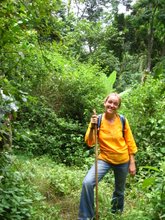 |
| Los arcos de Atolinga, gateway to the town from Tlatlenango |
Heather here! In this blog I've fashioned myself a cigarra, cigale, or cicada -- that is, a musical creature humming and buzzing with perpetual movement. I began this blog while in Tanzania in 2007-8, which is why you won't see a lot of entries since then. I'd like to continue it here in Mexico to observe and document my adventures and experiences. I received a Róbles-Garcia Fulbright Scholarship to teach and do research in Guadalajara, Atolinga, and Agua Zarca, Mexico for the year. I will be teaching a course on US immigrant literature at the Universidad de Guadalajara (UDG) starting in November, and have already begun research in the field, en el campo. After some tales from rural Atolinga and Agua Zarca, I will circle back to the present in Guadalajara.
Mi llegada
Arrived two nights ago from a week in Atolinga, Zacatecas, a town of about 3000 permanent inhabitants, located just over the state line from the northernmost area of Jalisco. On August 3, I traveled by Omnibus from Guadalajara to Tlatlenango, Zacatecas to meet my friend Chavo and his family there. In Tlatlenango we shared mariscos and gulped down a sweet and nutritious licuado of milk, banana, granola and nuts (we opted out of the tiny speckled golondriz eggs) while strolling around the market and noticing the word for cream is joque (a cream reminiscent of lait caillé), then took the combi from there to Atolinga in the company of Isa, who, having grown up in Bloomington, Illinois, had returned to Atolinga with her brother for this special week. On the trip there we rode up until we reached a kind of mesa and commented that, with the sunset colors, it seemed a kind of paradise or tierra prometida. Biblical references aside, I felt honored to finally see Atolinga and meet my friend’s family, who opened their arms to me for the week. By entering into their lives there during the feria patronal (a week-long series of fiestas devoted to San Cayetano and culminating in the siete de agosto) I got a glimpse into the town and its customs and feel ready to tell, from my perspective, select stories about the people I came to know this week – people who either live there or return there from the US during the fiestas.
Historia de los lugares y del paisaje
Atolinga is located in southern Zacatecas, whereas Agua Zarca is in northern Jalisco. People living in the towns regular cross state lines. The two states share many features, one of which is their high degree of outmigration (although supposedly Zacatecas currently outranks Jalisco), and the northern region (called El Norte de Jalisco) has looked more often to the city of Zacatecas than to Guadalajara as its cultural center. Following Independence, writes one historian, power networks were established by elites with little connection to the center of Jalisco, converting la región norte de Jalisco into a zone of refuge similar to those of the Coras and Huicholes in the Northwestern part of the state. The absence of economic development in this region meant that, in the 20th-century, campesinos would depend strategically on the migratory flows of Braceros to the United States for their survival. In the last fifty years, migration to other parts of Mexico and emigration to the US has completely de-structured the regional society in the North of Jalisco, even in spite of high birth rate, these migratory flows leaving the region virtually empty.* (in the following section, which I am currently drafting, I will describe the history and geography of the region, as well as its shifting cultural identity).
* Eliseo López Cortés, “Cambio sociocultural en la sociedad regional del Norte de Jalisco. Un modelo de análisis longitudinal.”

2 comments:
I love the cicada metaphor.
Thanks, my friend!
Post a Comment